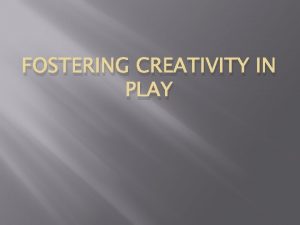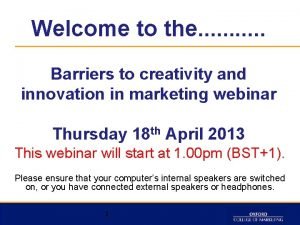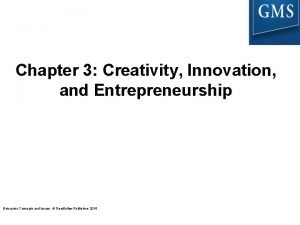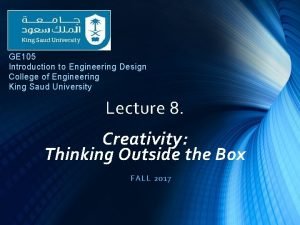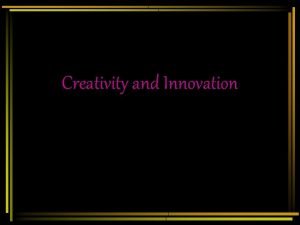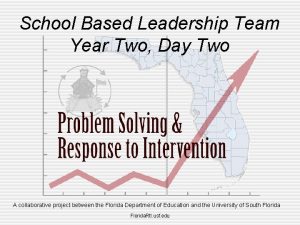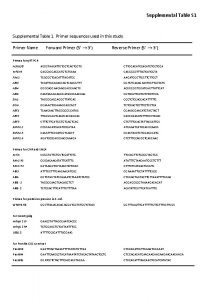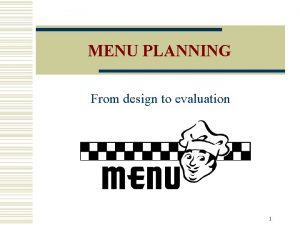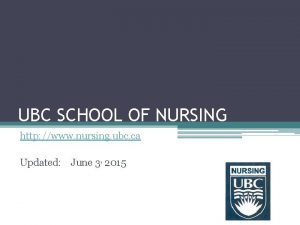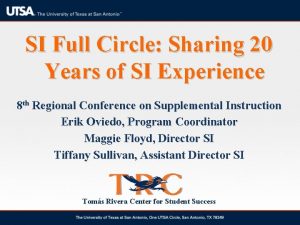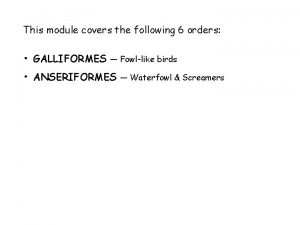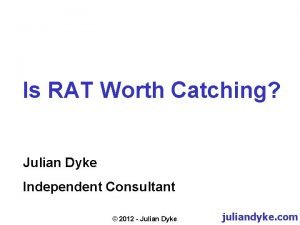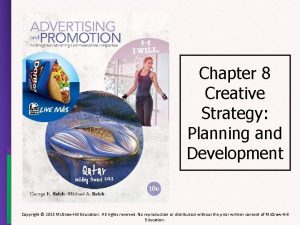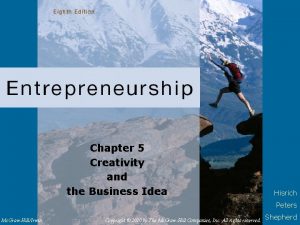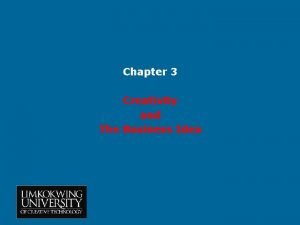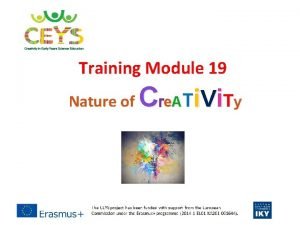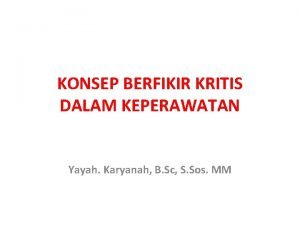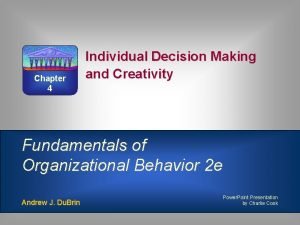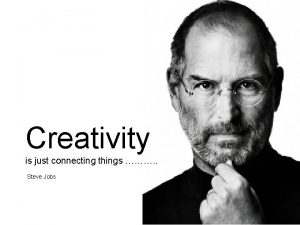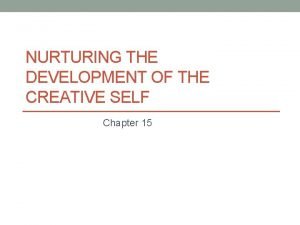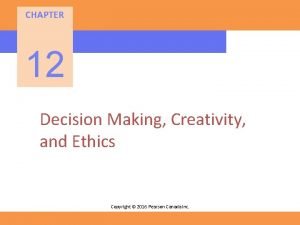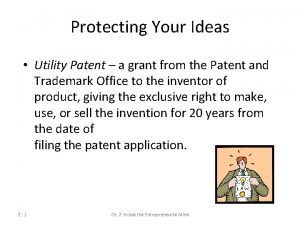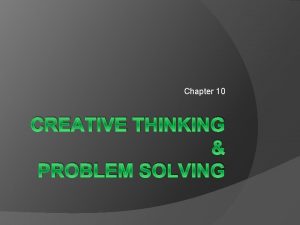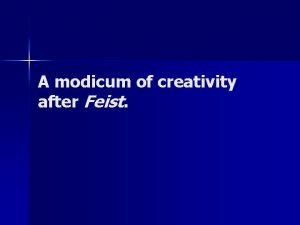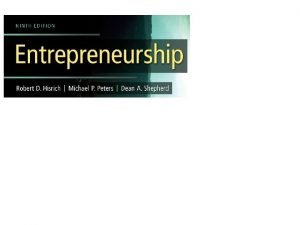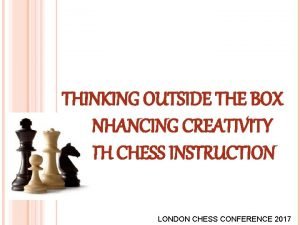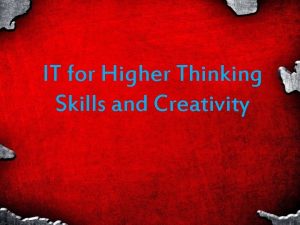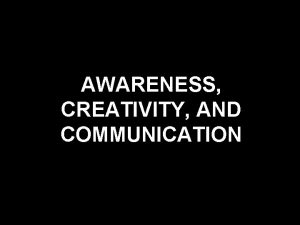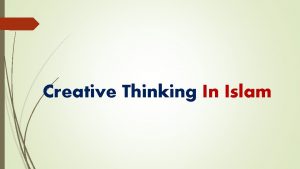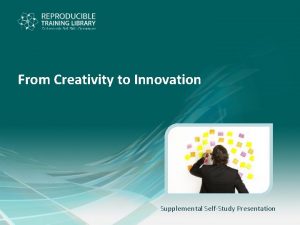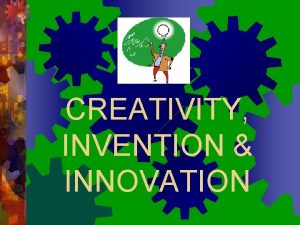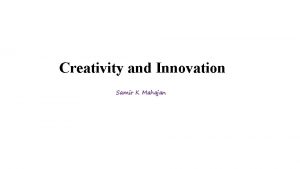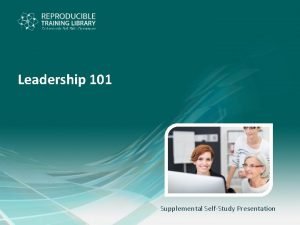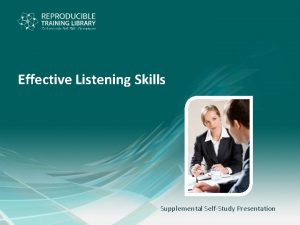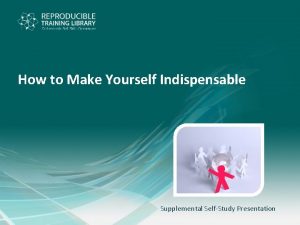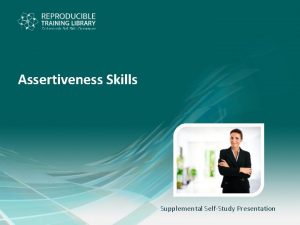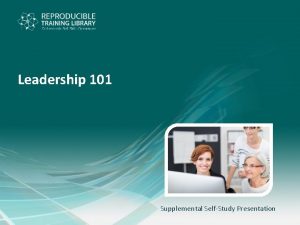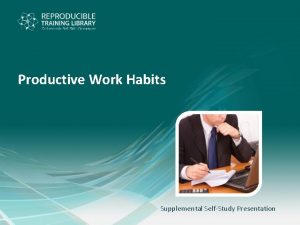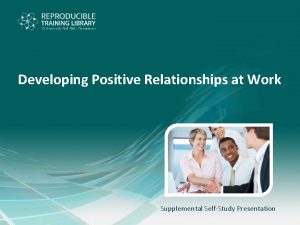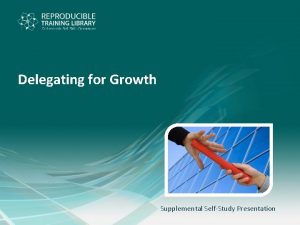From Creativity to Innovation Supplemental SelfStudy Presentation From



























































- Slides: 59

From Creativity to Innovation Supplemental Self-Study Presentation

From Creativity to Innovation Overview

From Creativity to Innovation Introduction After you’ve completed this course, you’ll be able to recognize common myths and misconceptions about innovation. You’ll be able to use multiple intelligences to generate a variety of ideas. You’ll know how to apply the characteristics of creative people to any problem or issue. You’ll be prepared to follow a four-step process for team innovation. You’ll be more skilled at promoting innovation without regulating it. You’ll be able to use cross-functional teams to foster innovation. And last, but not least, you’ll know how to spot sacred cows in your organization.

From Creativity to Innovation Module 1: Myths and Misconceptions

From Creativity to Innovation What is Innovation? Innovation is any idea that improves the cost/benefit ratio, either by increasing benefits or decreasing costs. At its essence, the goal of innovation is to make something better. Increase Benefits Reduce Costs • Effectiveness • Saving money • Speed • Effort • Pleasure or fun • Complexity • “Coolness” factor • Skill level • Safety • Risk • Health • Inconvenience • Boredom • Pollution

From Creativity to Innovation What is Innovation Part 2 Innovation can be applied to any aspect of running an organization—its products or services, internal processes, individual tasks, etc. A good place to begin looking is wherever you hear people saying, “If only…” Whatever that “if only” is, it could probably benefit from innovation. “Creativity is not the finding of a thing, but the making of something out of it after it is found. ” —James Russell Lowell

From Creativity to Innovation Myths and Misconceptions Increasing benefits or decreasing costs seems like a pretty simple proposition. So why does innovation seem irrelevant or impossible to many people? We’ll look at some common myths that contribute to that mindset. Myth: Only “creative” people can be innovative. • Some people are naturally creative and full of ideas, and it is important to recognize them and tap into their ideas. However, one person is rarely single-handedly responsible for fostering all the innovation in any organization. • Everyone can be creative and have good ideas. What does it take? Motivation, practice, access to a variety of knowledge resources and perspectives, and the ability to express ideas.

From Creativity to Innovation Myths and Misconceptions Part 2 Myth: The “revolutionary” idea is the only way to be innovative. Many small, continual baby steps can take an organization farther than one rare, giant step. • Revolutionary ideas can have a huge impact on an organization or entire industry; however, they are hugely disruptive and usually take years to reach their full potential. • Small changes, pilot projects, and new networks of collaboration help ensure the long-term success of an organization as much as a revolutionary idea.

From Creativity to Innovation Myths and Misconceptions Part 3 Myth: People like innovative ideas. Truth: People don’t like change, especially if they feel it has been forced on them. Change involves risk and the unknown, and some people are especially resistant to both. Typical criticisms: • “This will never work. ” • “It’s working just the way it is. ” • “What’s the point? ” What’s behind the criticism? • Fear: ”I’m afraid of change. ” • Envy: “I’m jealous I didn’t think of it myself. ” • Laziness: “I don’t want to learn something new. ”

From Creativity to Innovation Myths and Misconceptions Part 4 Myth: If an idea is good, it will stand on its own merits. • Many people feel that once they have thought of a good idea, the hard work is done. Or, if the idea is worthwhile, it will sell itself and everybody will recognize its value. • Unfortunately, thinking of a good idea doesn’t guarantee that it will be accepted and implemented. It can take a great deal of time and persistence to sell an idea. “Don’t worry about people stealing your ideas. If your ideas are any good, you’ll have to ram them down people’s throats. ” —Howard H. Aiken, inventor

From Creativity to Innovation Test Your Knowledge Test your knowledge of myths and misconceptions about innovation by taking this quiz. Read each example and decide if it is a myth or reality about innovation. Click on the item to reveal the answer. MYTH A good idea will sell itself. MYTH Good ideas are always popular. It can take a great deal of time and persistence to sell a good idea. REALITY You’re either creative MYTH or you’re not.

From Creativity to Innovation Module 2: Individual Innovation

From Creativity to Innovation Multiple Intelligence In this chapter, we’re looking at ways individuals can use multiple intelligences to develop a wide variety of ideas. Howard Gardner originated the idea of multiple intelligences in his book, Frames of Mind in 1983. His groundbreaking work correlated each intelligence with a specific part of the brain. After publishing his original work, Gardner added an eighth intelligence, the naturalist.

From Creativity to Innovation “Word Smart” The first intelligence we’ll examine is being “word smart. ” Word smart is verbal-linguistic intelligence: In other words, the capacity to use words effectively, orally or in writing. Word intelligence can be identified with the following clues: Someone who: • Is an avid reader • Likes to talk a lot • Says, “I hear what you’re saying. ” Ways to tap into this intelligence to innovate: • Surround yourself with books. • Keep a journal and write out ideas. • Listen to books on tape. • Keep track of ideas with a voice recorder.

From Creativity to Innovation “Picture Smart” The next intelligence is “picture smart. ” Picture smart is visual-spatial intelligence—the capacity to visualize and graphically represent concepts. Clues to this intelligence include people who: • Like pictures • Like to draw • Say, “I see your point. ” If you are picture smart, you can tap into this intelligence by: • Using mind maps, graphs and charts • Creating models • Keeping lots of drawing supplies on hand • Watching visual media

From Creativity to Innovation “Body Smart” Body smart is the next intelligence. It is bodily-kinesthetic intelligence or the capacity to use one’s body to express ideas and concepts. Ways to spot this type of intelligence include someone who: • Likes sports or physical activity • Is well-coordinated • Learns by doing • Says, “I’m in touch with that. ” If you are somebody who is body smart, tap into it in the following ways: • Role play when trying to problem solve. • Go for a walk to think. • Keep toys at your desk, such as a Koosh ball, Slinky, or Nerf toys to toss around while wrestling with a problem.

From Creativity to Innovation “Numbers-Reasoning Smart” The next intelligence we’re looking at is “numbers smart, ” which is logical-mathematical intelligence. It is the capacity to reason well and use numbers effectively. If you are numbers smart, you probably: • Like working with numbers or reasoning • Spot patterns quickly • Solve logic puzzles easily • Say, “That adds up. ” Use number smart intelligence to innovate by: • Setting up a problem statement to solve • Creating an “if-then” statement to solve • Asking “what if” or “why” to get to the source of the problem

From Creativity to Innovation “Music Smart” The next intelligence is “music smart” or musical-rhythmic intelligence. This is the capacity to perform or perceive melody, rhythm, pitch and other aspects of a musical piece, and it is usually easy to spot. People with music smart intelligence: • Can sing or play an instrument • Can sing or play a song after hearing it just once • Make tapping sounds or sing or hum while working • Say, “I’m in tune with that. ” In order to tap into this intelligence to innovate: • Listen to background music while working. • Write a song or chant related to a problem or concept.

From Creativity to Innovation “People Smart” The next intelligence is being “people smart. ” This is interpersonal intelligence or the capacity to recognize feelings, moods, and intentions of others and respond appropriately. Clues to help you identify this intelligence include people who: • Like to talk over problems with others and vice versa • Feel comfortable in a group • Say, “I can relate to that. ” There are several ways to tap into this intelligence. You can: • Brainstorm in a group. • Work with a partner or team. • Socialize with others.

From Creativity to Innovation “Self Smart” Self smart is intrapersonal intelligence. This means the capacity to recognize inner moods, intentions and desires of yourself; self-understanding, self-esteem, and self-discipline. Self-smart people can typically be identified in the following ways. They: • Like to spend time alone • Engage in hobbies or activities that can be done individually • Say, “That feels right to me. ” If you are self-smart, tap into this intelligence to innovate by: • Allowing time for self-reflection and unstructured times to think • Finding a place to “hide out” if your desk space isn’t private • Jotting down your self-talk and internal thoughts throughout the day

From Creativity to Innovation “Nature Smart” The final intelligence is nature smart. Nature smart is naturalistic intelligence; the capacity to relate to animals and plants and a sensitivity to the environment. Nature smart people: • Like to be outdoors • Enjoy gardening • Enjoy having pets or taking care of animals • Are sensitive to weather changes, bothered by pollution • Say, “I sense what you’re saying. ” If you are nature smart, tap into this intelligence to innovate by: • Going outdoors • Keeping a plant at your desk • Posting nature scenes at your desk

From Creativity to Innovation Test Your Knowledge Take a few moments to complete this quiz to review what you’ve just learned. Read the descriptions and identify which multiple intelligence each represents. When you’re ready, click on the descriptions to reveal the correct answers. Numbers smart quickly Spots patterns smart Likes. Nature to be outdoors Likes tosmart talk over problems with others People Avid Word readersmart Body smart Learns by doing Hums. Music whilesmart working Engages Self smartin activities that can be done alone Likes. Picture modelssmart and illustrations

From Creativity to Innovation Multiple Intelligences and Innovation If you only use a word smart or numbers smart approach to thinking of ideas, you’re missing the perspectives of other intelligences. For example, let’s say a group of city planners is working on a project to improve the process for communicating with citizens about proposed land use changes. Here are some ways you can tap into multiple intelligences to develop ideas: • Word smart: Produce a written report describing the proposed changes. • Picture smart: Provide maps of the proposed changes. • Body smart: Lead a tour through affected areas. • Numbers smart: Create a chart of the pros and cons of the proposed changes. • Self smart: Offer citizens a way to provide their feedback on how they feel about the proposed changes.

From Creativity to Innovation Multiple Intelligences and Innovation Part 2 Here are more ways you can tap into multiple intelligences to develop ideas: • People smart: Hold a face-to-face Q&A session with citizens. • Music smart: Develop a multi-media presentation with sound and music that shows the proposed changes. • Nature smart: Describe and show with photos how the natural habitat (plants and animals) will be affected by the proposed changes.

From Creativity to Innovation Test Your Knowledge Here is one last review of multiple intelligences. For each strategy, identify the type of intelligence for which it is most appropriate to use (word, picture, body, numbers, music, people, self, or nature). When you’re ready click on each to reveal the correct answer. Numbers Create an “if-then” statement Find Self a place to “hide out” Go outdoors Nature Picture Use mind maps, graphs, and charts Word Keep a journal Peoplewith others Brainstorm Listen to background music Music Role Body play to work through ideas

From Creativity to Innovation Characteristics of Creative People Everyone can be creative by adopting the characteristics that naturally creative people have: curiosity, imagination, and a willingness to take action. Curiosity To be curious: • Use all of your senses to notice the world around you. • Notice how different people go about completing the same task. • Ask questions. Sound like a toddler and ask “why” a lot. Why?

From Creativity to Innovation Characteristics of Creative People Part 2 People with an active imagination are able to create an environment that is conducive to triggering creative energy. Imagination • Don’t place any self-limitation, constraints, or inhibitions to your ideas. • Tap into an environment that fosters creative thoughts: Go outdoors, think in the shower, go on a walk or run, or play music. • Actively capture thoughts and ideas: Use a notebook, sticky notes, sketch book, or voice recorder to capture random thoughts that may lead to great innovation.

From Creativity to Innovation Characteristic of Creative People Part 3 Willingness to Take Action • Creative people have no fear of failure—or they simply feel the fear and do it anyway. They translate a fear of failure into learning from mistakes. • Have passion—for the idea, the commitment to improve, and for the positive change that will result from implementing the idea. • Have persistence. It is rumored that Thomas Edison tried 10, 000 experiments before finding the perfect set-up for the light bulb.

From Creativity to Innovation Questions are the Key to Solutions The best way to get one good idea is to get a lot of ideas. Professional photographers take hundreds or thousands of shots to capture the one perfect shot. Here are some suggestions for generating multiple ideas. • Think in plurals. Instead of: “What is the meaning of this? ” Ask: “What are the meanings of this? ” “What are the results? ” “What are the answers? ” • Don’t stop at the first solution. Find more than one right answer. • Ask a different question. Instead of “What is the best way to eliminate excess inventory? ” Ask: “What are the best ways to eliminate excess inventory? ” “How can we monitor inventory levels? ” “How can we match customers’ needs to inventory levels? ” Or ask the opposite: “What is the best way to add excess inventory? ” and then figure out a way to do the opposite.

From Creativity to Innovation Questions are the Key to Solutions Part 2 One of the best questions you can ask is “What if…? ” Start with the most outrageous ending you can think of. For example, “What if everyone in the world spoke the same language? ” “What if you could control the weather? ” Then, answer the question with at least three possibilities. To turn your “what if” possibilities into stepping stones toward practical applications, try using these tips: • Look for all the positives first. Identify what is interesting and potentially useful. • Follow this rule: For every idea that is rejected, come up with another idea or application.

From Creativity to Innovation Module 3: Team Innovation

From Creativity to Innovation Stages of the Creative Process Module two looked at how individuals can approach thinking of new ideas. In this module, we’ll look at a process for teams to use to innovate. Graham Wallas described a four-stage creative process in 1926. Most subsequent models, including this one, are based on his original description. Initiation Step 1. Initiation Step 2. Gestation Step 3. Eureka Step 4. Application Gestation We’ll look at each step in detail in the next few slides. Eureka

From Creativity to Innovation Initiation The purpose of the first step, initiation, is to define the issue, situation, or problem. This is often primarily a data-gathering step and the issue may get redefined as more information is collected. To define the problem, issue or situation, ask these questions: • o Who does it affect? Who does it not affect? o When is it a problem? When isn’t it a problem? o What would you like to change or improve related to the problem, issue, or situation? • Immerse yourself in the problem. • Gather information and data. • Define roles and areas of interest and loosely coordinate tasks.

From Creativity to Innovation Gestation During the gestation period, the second step, team members will contemplate the problem on their own and as a team. “What if…? ” • • The team may not meet for a while, but the issue is percolating. Progress may appear to be stalled or the issue neglected, but individuals’ minds are still at work. Encourage people to capture all thoughts and ideas, no matter how unrealistic, impractical, or improbable. Team members should be encouraged to apply the individual innovation concepts and ideas from the previous chapter in this step.

From Creativity to Innovation Eureka At some point, an “aha” idea will occur. It can be difficult to predict what will trigger it. • It may or may not be a startling “eureka” moment. • It may simply be a new angle on the problem. • It may be a burning desire to get to work on the problem—a sign of “creative labor pains. ” • It may be the result of getting the original group together that sparks a “wow” idea that no one person had previously considered.

From Creativity to Innovation Visualization is a way to mentally “test out” an idea and is useful in the eureka phase. Try it using these steps: • Reduce distractions. It usually helps to close your eyes when visualizing. • Create a screen. Picture a movie screen in your mind and look at your visualization almost as an objective observer. • Advance the images. Start with your idea, then add complexity to it. For example, if it’s a new technique or process, picture real people you know using it. See what they are doing and what they are saying, and what their reaction is. • Transfer the images. What actions do you and others need to take to make it a reality?

From Creativity to Innovation Application This stage requires interpersonal and sales skills more than technical skills. Even great ideas can take a long time to be accepted. You need patience, persistence, courage, enthusiasm, encouragement, teamwork. Consider the following issues when promoting your idea: • List the ways that the idea or innovation will improve on the current product, service, process, task, etc. • What other innovations will be enabled by this innovation? • How easy is it to implement? Is there a prerequisite (some necessary change) before this innovation can be put into place? • What is the downside if the innovation isn’t implemented? Answering these questions will strengthen your case for implementing your idea.

From Creativity to Innovation Application Part 2 Once your idea has buy-in or been approved (if necessary), develop a thorough game plan. It should include the following elements: • A step-by-step action plan, with an associated timeline for each step. • A budget that breaks out costs for each step. • A list of the people who should be involved and what their roles should be. • A communication plan that keeps those directly involved, stakeholders and end users, in the loop. • A list of potential obstacles and how you will handle each one. • A “bail out” plan in case something happens that forces you to discontinue application.

From Creativity to Innovation Test Your Knowledge Take a few moments to complete this quiz to review what you’ve just learned. Read each task and decide what stage of the creative process it is a part of. Click on each item to reveal the answer. Capture all thoughts and ideas, no mater how unrealistic or improbable. Gestation Sell the idea or solution using interpersonal skills more than technical skills. Application Gather information and data. Initiation Act on a burning desire to get to work on the problem. Eureka

From Creativity to Innovation Module 4: Organization Actions

From Creativity to Innovation Promote Innovation without Regulating It This module looks at what organizations can do to support innovation. The risk of promoting innovation from a corporate perspective is that people may come up with “innovations” for the sake of meeting a corporate goal, but they don’t really improve anything. You want to avoid creating a “flavor of the month” innovation program that will be quickly forgotten when the next corporate program is rolled out. “The things we fear most in organizations—fluctuations, You should aim for two distinct corporate behaviors: disturbance, imbalances—are the 1. Embed an attitude of innovation in every employee. primary sources of creativity. ” —Margaret J. Wheatley 2. Encourage many approaches: • Balance business as usual with new and non-standard projects. • Balance internal with external (customer-focused) ideas. • Balance revolutionary (audacious) with evolutionary (incremental) ideas.

From Creativity to Innovation Promote Innovation without Regulating It Part 2 Here are more ideas for how to promote innovation without regulating it: • Seek solutions, not just ideas. Define and prioritize your business needs, and share that information with every employee. • Find a business partner who’s experiencing a challenge, and focus on finding a solution to that challenge. • Move from “push” to “pull”: from pushing innovation onto the employees as a “have to” task to employees seeking help to implement their ideas. • Share success stories. Recognize, reward, and communicate innovations across the entire organization.

From Creativity to Innovation Lessons from Pixar You probably recognize Pixar as the award-winning studio that makes animated films. The lessons below were shared by Brad Bird, an Academy Award-winning director and Pixar executive, in an interview with Mc. Kinsey Quarterly. Take another look at your black sheep. • Frustrated employees probably have another way of doing things that no one else is interested in. • Give them a chance to try out their ideas. • Consider putting them on stale teams to reinvigorate the team. Look for passionate people. • They are not always the loudest or most visible, but all share a restless, curious nature. • They believe in the unbelievable.

From Creativity to Innovation Lessons from Pixar Part 2 Messy can be good. • If you wait until something is perfect, it may never happen. • Know when “good enough” is good enough. Interaction = innovation • Create “hang out” areas so that people run into each other. o Central meeting rooms o Lunch rooms o Outdoor spaces • Encourage inter-disciplinary learning and crosstraining.

From Creativity to Innovation Mixing it Up As you just learned, mixing it up with other people in your organization is a good way to encourage innovation throughout the company. A structured cross-functional team has many benefits: • Creativity: A clash of ideas and perspectives changes patterns of thinking and inspires new solutions. • Complexity: Cross-functional teams are better able to solve complex problems than single-function teams. • Organizational learning: Team members gain important knowledge about other areas of the organization. • Enthusiasm: Exploring other aspects of the organization helps combat monotony and keeps employees motivated. • Maturity: Working with different situations and kinds of people helps employees mature.

From Creativity to Innovation Find Your Sacred Cows What is a sacred cow? It is a belief, assumption or rule (written or unwritten) that is immune to criticism or challenge. Many sacred cows are “tried and true” processes or ways of doing things that employees feel comfortable with. They often become obstacles to innovation. Examples: • “The leader is always right. ” • “Past track record is the best predictor of future success. ” • “Internal competition leads to better results. ” • “Mistakes are bad. ” • “The customer is always right. ” • “Don’t offend anyone. ” What sacred cows exist in your organization?

From Creativity to Innovation How to Spot a Sacred Cow In order to spot a sacred cow in your organization, put everything on the table. • Challenge established practices to see whether it’s a smart way to do business, or if it’s a sacred cow. Make every aspect of the business prove itself. • Ask yourself, “Why did this process, program, project come to be? Do the reasons still exist? ” Or simply, “Why are we doing this? ” Example: An organization that believes in conducting elaborate online surveys measuring employee satisfaction, but employee satisfaction never improves. If the answer to “why are we doing this? ” is “because we’ve always done it this way, ” then you have spotted a sacred cow.

From Creativity to Innovation Test Your Knowledge Take a few moments to complete this quiz to review what you’ve just learned. Read each statement and decide if it is true or false. Click on the item to reveal the answer. There is a potential downside when organizations promote or sponsor innovation programs. TRUE When you ask employees to think of solutions in addition to ideas, you stifle their creativity. FALSE The most passionate people in your organization are the loudest and most visible. FALSE The best way to recognize a sacred cow is to ask, “Why are we doing this? ” TRUE

From Creativity to Innovation Review

From Creativity to Innovation CASE STUDY—Apply What You’ve Learned Read the case study and answer the questions that follow in order to put your [XX] skills into practice. Organization: The counseling department of a large, public high school. People: A team of five counselors: Denise, Erica, Tara, Will, and Javier. Situation: Each member of the counseling team is responsible for about 400 students. The team has recently returned from attending a conference for high school counselors and is excited about trying to incorporate some of the ideas they heard about at the conference into their own counseling department. But one thing wasn’t addressed, and it’s a source of concern to all of them—their post-graduate resource center is severely under-utilized.

From Creativity to Innovation CASE STUDY—Apply What You’ve Learned Part 2 The team is familiar with the four stages of the creative process and decides to use that process to structure their approach. The first thing they do is get together and define the problem. They come up with the following problem statement: “Our post-grad resource center is under-utilized and we want every student to understand what is available and how they can use it to get the help they need to make decisions related to their lives after high school. If we don’t change current utilization rates, the post-grad resource center may lose some funding and further reduce its usefulness. ”

From Creativity to Innovation CASE STUDY—Apply What You’ve Learned Part 3 Next, the team decides it will take a week to contemplate the issue. Before the week is up, Javier sends out an email blast to the students reminding them about the center and its hours. The rest of the team is surprised, but hesitant to criticize Javier because after all, he is trying to do something positive and action-oriented. The next time the group meets, they brainstorm and agree to try several ideas in addition to Javier’s email blast, including making a video that they will post on You. Tube, and add a new feature in the monthly newsletter that gets distributed to students and their parents, which will highlight a different student using the resource center each month. A month later, they discover the cost to produce the video is much greater than they had anticipated, and they’re having trouble finding students who are willing to be featured in the newsletter.

From Creativity to Innovation CASE STUDY—Questions to Consider 1. In general, how well did the team carry out each stage of the process? 2. How well did the team write its problem statement? 3. Was Javier’s independent action (sending the email blast) helpful or hurtful? What could he have done differently? 4. The team ran into a couple obstacles when they tried to implement their ideas. How could they have prevented or prepared for them, and what can they do now to overcome those obstacles? Review the ideas and suggested answers provided on the following slides.

From Creativity to Innovation CASE STUDY—Suggested Answers 1. In general, how well did the team carry out each stage of the process? They completed each stage, but not always very well. Initiation: They identified the problem, but didn’t do much, if any, information gathering and they didn’t assign any roles or tasks. Gestation: It is more difficult to determine how well this stage was carried out. There is no evidence that any of the counselors used any formal strategies to think of or capture ideas. Eureka: The group brainstormed, which is a useful tool in this stage of the creative process. Application: The group had ideas to implement, but made no attempt to gain buy-in from students and other stakeholders, or to create a game plan with a timeline, budget, communication plan and potential obstacles. As a result, they were unprepared to deal with the obstacles they ran into a few weeks later. 2. How well did the team write its problem statement? The team did a pretty good job of writing the problem statement—they stated the issue, who it affects (students), and what they would like to change or improve (allow students to get the help they need to make decisions related to their lives after high school). However, the statement is quite broad and doesn’t specifically state that they want to find the reason(s) the center is being under-utilized. Therefore, the ideas they generate may address the symptom (not enough users) but not ultimately address and fix the underlying reasons for that.

From Creativity to Innovation CASE STUDY—Suggested Answers Part 2 3. Was Javier’s independent action (sending the email blast) helpful or hurtful? What could he have done differently? There doesn’t appear to be any major drawbacks to Javier’s action. However, if Javier had informed his fellow team members, it might have sparked an even better idea among team members. 4. The team ran into a couple obstacles when they tried to implement their ideas. How could they have prevented or prepared for them, and what can they do now to overcome those obstacles? The team could have prepared for the obstacles by creating a thorough game plan. In fact, it is likely they could have avoided these particular obstacles altogether with better planning. For example, they could have developed several budgets for the video—a high-end, medium, and low-end. And if they had created a communications plan and involved students up front, they probably would have gained buy-in to their newsletter idea and easily found volunteers to highlight in the newsletter. In addition, they may have even found students interested in making videos who might have some really creative ideas—at a low cost. To overcome the obstacles now, they need to backtrack and gain buy-in from students, parents, and other stakeholders by communicating clearly what they are trying to accomplish, and how they can help.

From Creativity to Innovation Congratulations! By now you should be able to: • Recognize common myths and misconceptions about innovation. • Use multiple intelligences to generate a variety of ideas. • Apply the characteristics of creative people to any problem or issue. • Follow a four-step process for team innovation. • Promote innovation without regulating it. • Use cross-functional teams to foster innovation. • Spot sacred cows in your organization.

From Creativity to Innovation Appendix

From Creativity to Innovation References Armstrong, Thomas. 7 Kinds of Smart. New York: Penguin Books, 1993. Berkun, Scott. The Myths of Innovation. Sebastopol, CA: O’Reilly Media, 2007. Fraser, Beau, David Bernstein and Bill Schwab. Death to all Sacred Cows: How Successful Business People Put the Old Rules Out to Pasture. New York: Hyperion, 2008. Hanks, Kurt and Jay Perry. Wake Up Your Creative Genius. Menlo Park, CA: Crisp Publications, 1991. Von Oech, Roger. A Whack on the Side of the Head. Menlo Park, CA: Creative Think, 1992.

From Creativity to Innovation © 2012 HRDQ. All rights reserved. Published by HRDQ and the HRDQ logo are registered trademarks of Organization Design and Development, Inc. This publication is distributed under the terms and conditions of the Reproducible Content End User License Agreement (EULA). For specific details, visit www. hrdq. com/legal. For more information about this publication or to order additional copies, please contact the HRDQ Customer Service Team by phone at 610 -279 -2002 or by email at custserv@hrdq. com. For more information about HRDQ products, visit www. hrdq. com. ISBN 978 -1 -58854 -996 -9 Title slide image: tommason lizzul/Shutterstock. com. Images used under license from Shutterstock. com. Microsoft®, Word®, Power. Point®, and Outlook® are registered trademarks of Microsoft Corporation. 2750 E 1 IIA EN-01 -NV-18
 Creativity and play fostering creativity
Creativity and play fostering creativity Creativity vs. innovation
Creativity vs. innovation How to overcome barriers to creativity and innovation
How to overcome barriers to creativity and innovation Definitions of creativity
Definitions of creativity Creativity innovation and invention
Creativity innovation and invention Creativity innovation and invention
Creativity innovation and invention Disruptive and radical innovation
Disruptive and radical innovation Innovation for the sake of innovation
Innovation for the sake of innovation What is ssi
What is ssi Mcas supplemental reference sheet
Mcas supplemental reference sheet Supplemental instruction
Supplemental instruction Supplemental table
Supplemental table Blank graphic organizers for math staar
Blank graphic organizers for math staar Supplemental instruction
Supplemental instruction Covin
Covin What is supplemental security income
What is supplemental security income Supplemental table 1
Supplemental table 1 Menu planning constraints
Menu planning constraints Supplemental table 1
Supplemental table 1 Supplemental aids examples
Supplemental aids examples Supplemental instruction
Supplemental instruction Ubc nursing
Ubc nursing Supplemental figure
Supplemental figure Alter database add supplemental log data
Alter database add supplemental log data Utsa si
Utsa si Galliform with supplemental molt
Galliform with supplemental molt Osocp
Osocp Iowa state vet school supplemental application
Iowa state vet school supplemental application Supplemental figures
Supplemental figures Alter system set optimizer_features_enable
Alter system set optimizer_features_enable Ssi vs ssdi
Ssi vs ssdi Tea supplemental aids
Tea supplemental aids Supplementary figure 1
Supplementary figure 1 Creative strategy planning and development
Creative strategy planning and development Usc kortschak center for learning and creativity
Usc kortschak center for learning and creativity Pritchon is a business idea sourced from
Pritchon is a business idea sourced from Creativity business idea
Creativity business idea Nature of creativity
Nature of creativity Manfaat berpikir kritis dalam keperawatan
Manfaat berpikir kritis dalam keperawatan Overactive sacral chakra
Overactive sacral chakra Conclusion of creativity
Conclusion of creativity Torrance creativity test examples
Torrance creativity test examples Decision making and creativity organizational behavior
Decision making and creativity organizational behavior Creativity support tools
Creativity support tools Steve jobs creativity is just connecting things
Steve jobs creativity is just connecting things What is creativity
What is creativity Usc kortschak center for learning and creativity
Usc kortschak center for learning and creativity Ethics and creativity are ________.
Ethics and creativity are ________. Conclusion of creativity
Conclusion of creativity Segg gegs gges egsg
Segg gegs gges egsg Define modicum
Define modicum Bisociative thinking
Bisociative thinking Chapter 4 creativity and the business idea
Chapter 4 creativity and the business idea Components of creativity ppt
Components of creativity ppt Guided hypermedia projects
Guided hypermedia projects Creative translation example
Creative translation example Awareness creativity and communication
Awareness creativity and communication How pixar fosters collective creativity
How pixar fosters collective creativity The creativity of linguistic knowledge
The creativity of linguistic knowledge Creative thinking in quran
Creative thinking in quran
